Argostoli immediately surprised me the moment I stepped off the ferry onto this lively Greek island capital. As the biggest town on Kefalonia, it’s got this fascinating mix of modern rebuilding and that laid-back island charm you kind of hope for in the Ionian Sea.
After the devastating 1953 earthquake, locals rebuilt almost the entire town. Now, you’ll spot rounded corners and pastel buildings everywhere—there’s a style here that feels both fresh and distinctly Kefalonian.
But what really makes Argostoli stand out? It’s the wild blend of natural wonders—loggerhead sea turtles swimming right into the harbor, mysterious sinkholes that swallow seawater, and caves where that same water pops up again, sparkling clean. I’ve joined plenty of visitors along the waterfront, all of us craning for a glimpse as these massive turtles surface near the docks. It’s honestly an unforgettable wildlife moment, just steps from the buzz of cafes and shops.
Argostoli feels like a place where history and nature keep bumping into each other. I wandered from lively plateias packed with locals sipping evening coffee to the world’s longest stone bridge stretching across the bay. Every corner seemed to offer something I didn’t expect.

Nearby, you’ll find underground lakes, dramatic caves, and that weirdly fascinating sinkhole where scientists once traced water with paint just to see where it would end up. Honestly, Argostoli turned out to be way more intriguing than I ever imagined.
Argostoli Harbor: Encounter Sea Turtles and Waterfront Life
Argostoli Harbor is hands-down one of the best spots in Greece for easy wildlife encounters. Each morning, loggerhead sea turtles glide through the shallow waters, right where the harbor meets the town.
The waterfront pulses with authentic Greek harbor life. You’ll find a scenic promenade lined with traditional tavernas, all overlooking the Ionian Sea.
Caretta Caretta: The Iconic Loggerhead Turtles
If you want to spot sea turtles, come early in the morning. That’s when they show up to feed in the shallows.
These loggerheads gather near the fishing boats and along the harbor walls. They munch on mussels stuck to the docks and hang around waiting for fishermen to toss out scraps.
Best viewing spots:
- Harbor walls near the fishing boats
- Koutavos Lagoon area
- Shallow edges of Argostoli Bay
The harbor and Koutavos Lagoon create ideal feeding grounds—calm, shallow, and packed with food. I’ve learned these turtles belong to the larger population that nests on southern Kefalonia beaches.
The harbor’s become their main feeding hangout during the day. It’s honestly wild how close you can get.
Promenade Walks and Harbor Views
The Argostoli waterfront is perfect for a slow stroll with clear views across the harbor. I like to watch the fishing boats drift in and out, always keeping an eye out for turtles below.
The promenade runs right along the main harbor, connecting the town center to the outer walls. It’s an easy walk.
Walking highlights:
- Morning fish market bustle
- Old-school fishing boats on display
- Turtle-watching from the harbor wall
- Crystal-clear water views
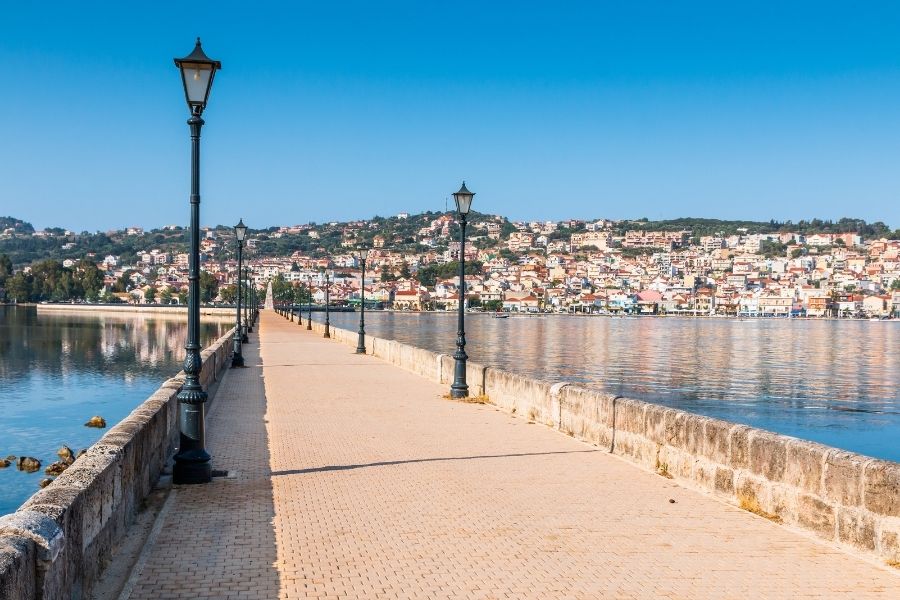
You don’t need a plan—just wander. The area’s compact, so you won’t get lost. Early mornings, when everything’s waking up, feel especially charming.
Schools of colorful fish dart through the water beside the turtles. The whole scene is lively, even underwater.
Dining and Cafés by the Sea
Tavernas and cafés line the waterfront, and I can’t resist grabbing a table with a view. There’s something about eating Greek food while watching for turtles and fishing boats that just feels right.
Many places serve fresh seafood caught that morning. The fish market supplies the restaurants directly.
Dining options:
- Waterfront tavernas with sea views
- Classic Greek cafés
- Bars with terraces overlooking the harbor
- Seafood restaurants with the catch of the day
Try to snag a harbor-view table in the morning. The light is beautiful, the turtles are active, and the weather’s just about perfect.
The whole restaurant scene feels local and real—no tourist traps here. Traditional Greek dishes just taste better when you’re this close to the water.
Bustling Plateias and the Heart of Argostoli
If Argostoli has a heartbeat, it’s in Plateia Valianou, the main square. Locals gather here all day, and I found it’s the best place for people-watching or just soaking up the town’s relaxed vibe.
Exploring Plateia Valianou
Plateia Valianou is Argostoli’s main gathering spot. It’s been recently pedestrianized, which makes it even more inviting.
The square buzzes with life from morning to late at night. Families bring their kids to play, and adults linger over coffee at the cafes that ring the square.
There’s a relaxed Mediterranean pace here. People move slower than in Athens or Corfu—nobody seems in a rush.
Best times to visit:
- Morning: Quieter, great for coffee
- Afternoon: Locals and families fill the square
- Evening: Lively, with dinner and drinks
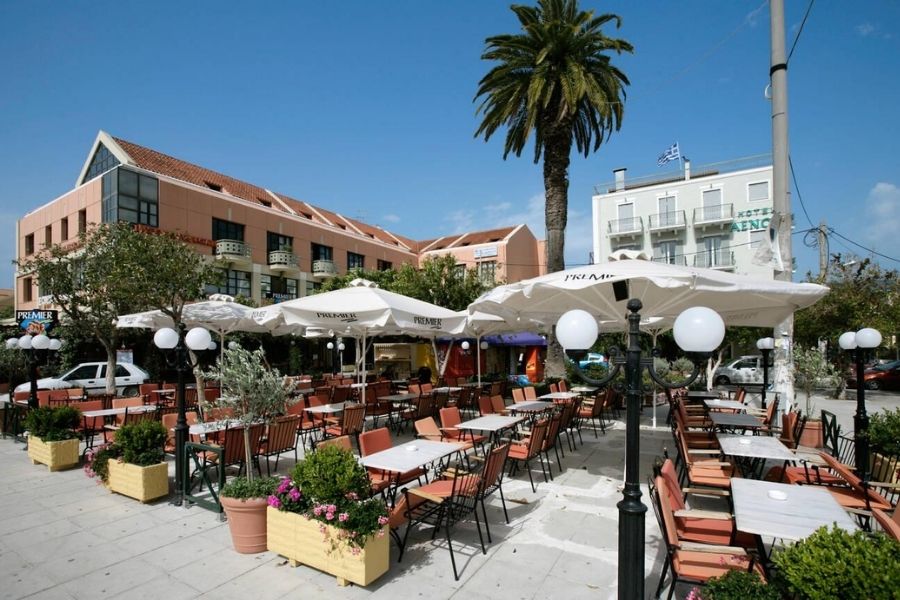
The square sits just a short walk inland from the harbor. I could wander between the two in minutes.
Local Shops and Markets
The streets around Plateia Valianou are packed with shopping options. You’ll find local crafts, everyday essentials, and little surprises all within a few blocks.
Family-owned shops line the streets. Many sell olive oil, honey, and handmade soaps—classic Kefalonia products.
The local market runs several days a week. Fresh produce from the island—tomatoes, herbs, seasonal fruit—tastes incredible.
What I picked up:
- Olive oil and honey
- Handmade jewelry and crafts
- Traditional Greek clothing
- Local produce and specialties
Prices are reasonable, especially compared to places like Santorini or Mykonos. I paid less here for better quality.
Most shop owners speak some English, and they often share stories about their products. I got a few good tips for exploring the rest of Kefalonia that way.
Cultural Events and Nightlife
Nightlife in Argostoli centers around Plateia Valianou and the nearby streets. It’s lively but never wild—don’t expect the party scene you’d find on Kos or Zante.
I love the evening dining scene most. Restaurants fill up with locals and travelers, all enjoying Greek meals and local wine.
On summer nights, the energy ramps up. Tables spill out onto the square, and people linger outdoors, chatting late into the evening.
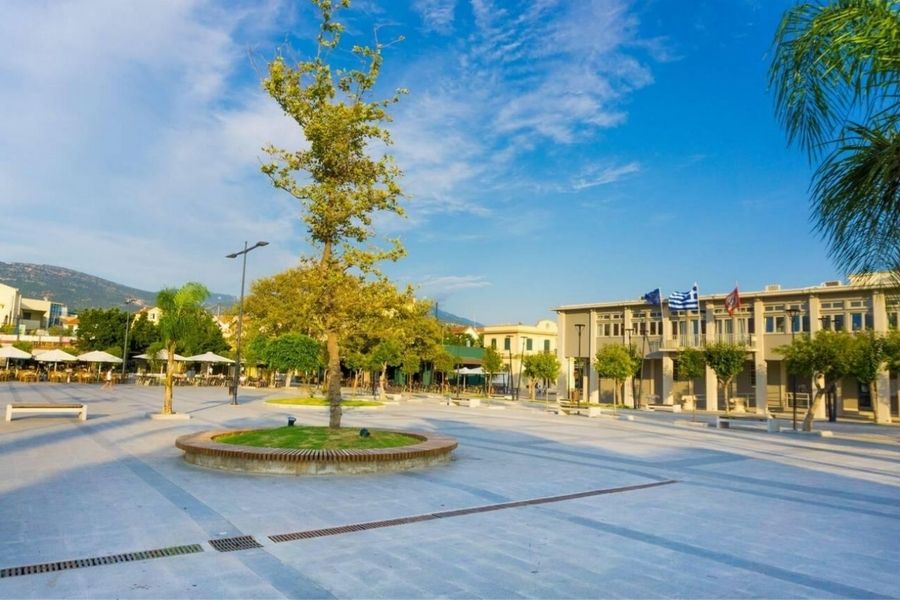
Nightlife here is about food, conversation, and a relaxed atmosphere. For me, it’s the best way to soak up Greek island culture.
Evening activities:
- Tavernas with live music
- Wine bars featuring local bottles
- Casual bars with outdoor seating
- Occasional festivals or music events
During summer, the town sometimes hosts cultural events right in the square. You might catch a traditional music performance or a festival celebrating Kefalonia’s heritage.
Drapano and the Historic Drapano Bridge
The De Bosset Bridge stands out as one of Kefalonia’s most impressive landmarks. It stretches nearly 700 meters across Koutavos Lagoon, linking Argostoli with the small village of Drapano.
This stone structure actually holds the world record for the longest stone bridge over seawater.
De Bosset Bridge: Architectural Marvel
The De Bosset Bridge, or Drapano Bridge, is one of those engineering feats that just grabs your attention. Charles Philippe De Bosset, a Swiss engineer and island governor, built it back in 1813.
He started with a wooden bridge to connect Argostoli to nearby villages. Four years later, workers added stone arches for strength.
After 26 years, they rebuilt the whole thing in stone. Walking across it almost feels like walking on water—it sits just above sea level, and the stone arches make for a dramatic sight.
The 1953 earthquake hit the bridge hard, sinking some sections lower. You can still spot the damage, even after repairs.
In 2018, the bridge officially earned the title of world’s longest stone bridge over seawater. It’s been a protected historical monument since 1970.
Drapano Village and Its Surroundings
Drapano sits at the far end of the bridge, a quiet village on the opposite shore of Koutavos Lagoon. Locals gave the bridge its name—most call it the Bridge of Drapano.
This little settlement offers a peaceful escape from the busier capital. The bridge gives you easy access to both sides of the lagoon.
From Drapano, you get a different view back toward Argostoli and the coastline. I always enjoy the perspective from here.
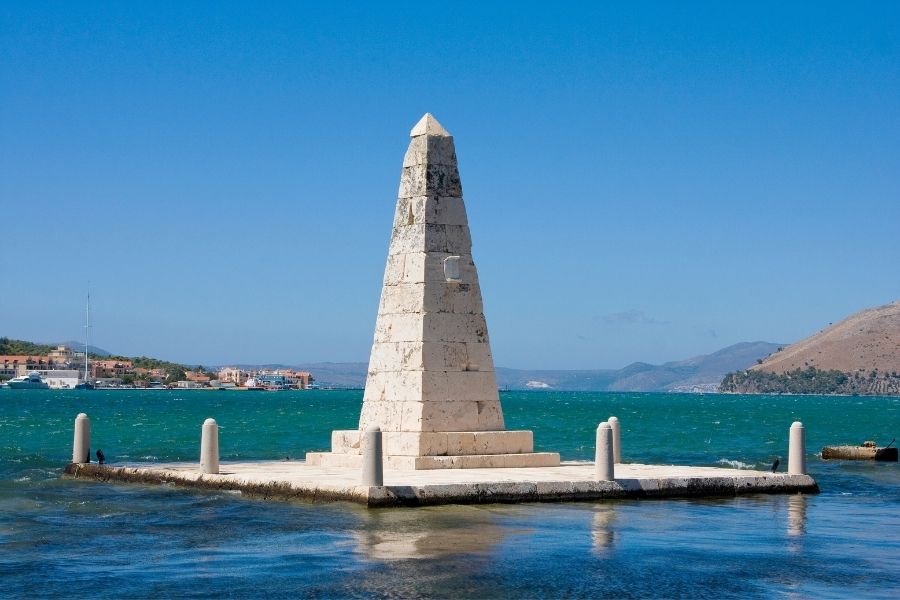
The bridge also separates the port area from Koutavos Lagoon, creating two distinct zones in the bay. This has helped keep the lagoon waters calm and the harbor functional.
Natural Wonders: Argostoli Sinkholes and Beyond
The Argostoli sinkholes are honestly one of Greece’s weirdest and most fascinating natural wonders. Seawater vanishes into underground caves, only to reappear—crystal clear—at distant springs.
Just nearby, the historic St Theodore Lighthouse marks a dramatic spot along Kefalonia’s coastline.
Unraveling the Mystery of Argostoli Sinkholes
Locals call the Argostoli sinkholes “Katavothres,” and they’re genuinely mind-bending. Right near Argostoli, seawater rushes into these holes at up to 3 meters per second, vanishing underground.
The secret? An underground karst system. Seawater enters the sinkholes on the west side of Kefalonia, travels 15 kilometers beneath the island, and pops up again as brackish water at Karavomilos springs near Sami.
Why does this happen?
- Sea level differences between inlet and outlet
- Heavy seawater mixing with lighter freshwater from Mount Aenos
- Ancient limestone caves carved out over ages
In the past, people used this powerful flow to run sea mills. An Englishman named Stevens built the first mill here in 1835 after seeing the water’s force.
Scientists finally proved the connection in 1963 by adding uranine dye to the sinkholes. Two weeks later, the dye showed up at Karavomilos springs—mystery solved!
St Theodore Lighthouse and Coastal Sights
The St Theodore Lighthouse stands tall near the sinkholes, right along Kefalonia’s coastal road. I always suggest visiting both together—they’re close and easy to reach between Argostoli and Lassi.
The lighthouse gives you sweeping views of the Ionian Sea and the surrounding pine forests (Pinus halepensis everywhere). It’s a great starting point for exploring the Agioi Theodoroi promontory.
From here, you can walk to the sinkholes and just take in the dramatic coastline. The scenery never disappoints.
Expect:
- Wide-open sea views
- Rocky shores and unusual formations
- Quick access from Argostoli center
- Plenty of photo ops
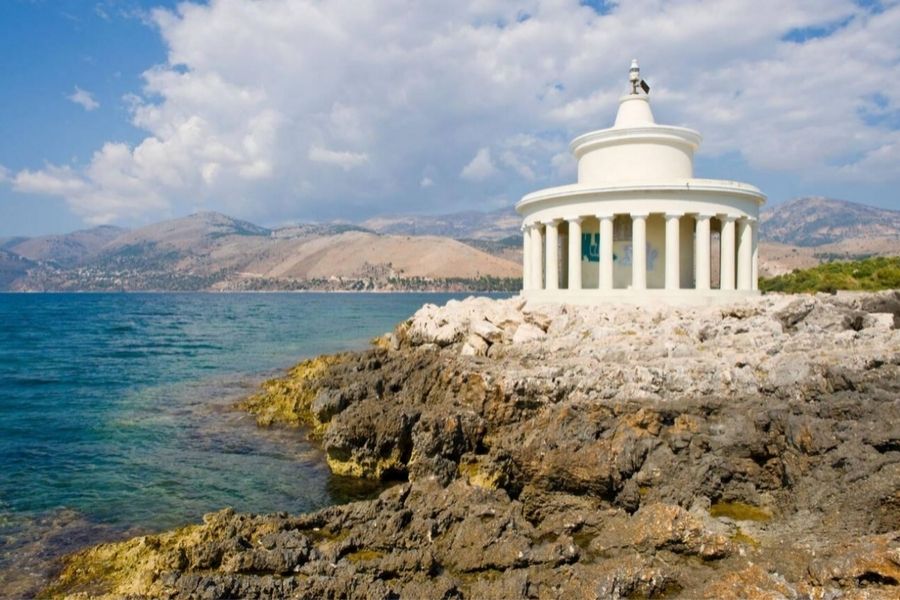
Pairing the lighthouse with the sinkholes makes for a perfect little outing from Argostoli. It’s a snapshot of Kefalonia’s wild natural beauty and quirky geology.
Excursions from Argostoli: Melissani Cave and Drogarati Cave
Two of Kefalonia’s most famous caves sit just a short drive from Argostoli. Melissani Cave hides a surreal underground lake where sunlight turns the water magical blue.
Drogarati Cave, on the other hand, wows you with towering rock formations inside a huge natural chamber.
Melissani Cave: The Sunlit Underground Lake
Melissani Cave honestly blew me away—it’s one of those places in Greece that feels like a hidden secret. You’ll find it about 20 minutes from Argostoli, tucked near the small town of Sami.
The lake inside stretches 350 meters long and 40 meters wide. What really makes it wild is the way seawater sneaks in through holes near Argostoli and pops up here 15 days later. Nature’s got its own magic tricks.
Key Features:
- The lake sits just 30 centimeters above sea level.
- The cave roof crashed in about 3,000 years ago.
- Archaeologists discovered ancient artifacts from the 3rd and 4th century BC here.
Small rowboats drift visitors around the lake. The water shifts from deep blue to this insane turquoise when sunlight pours through the hole in the ceiling. I watched the colors change as the sun moved—sometimes it almost glowed.
The name comes straight out of Greek mythology. Locals believed nymphs called these mysterious waters home, and honestly, it does have that otherworldly vibe.
Drogarati Cave: Awe-Inspiring Stalactites
Drogarati Cave first opened to visitors back in 1963. This underground chamber is ancient—about 150 million years old—and the temperature stays at a cool 18 degrees Celsius, no matter the season.
Getting down there took a bit of effort. I counted a lot of steps before reaching the main chamber. The cave plunges 60 meters deep, and the ceiling soars 20 meters above your head. Stalactites drip from above, while stalagmites poke up from below. It feels like walking into a natural cathedral.
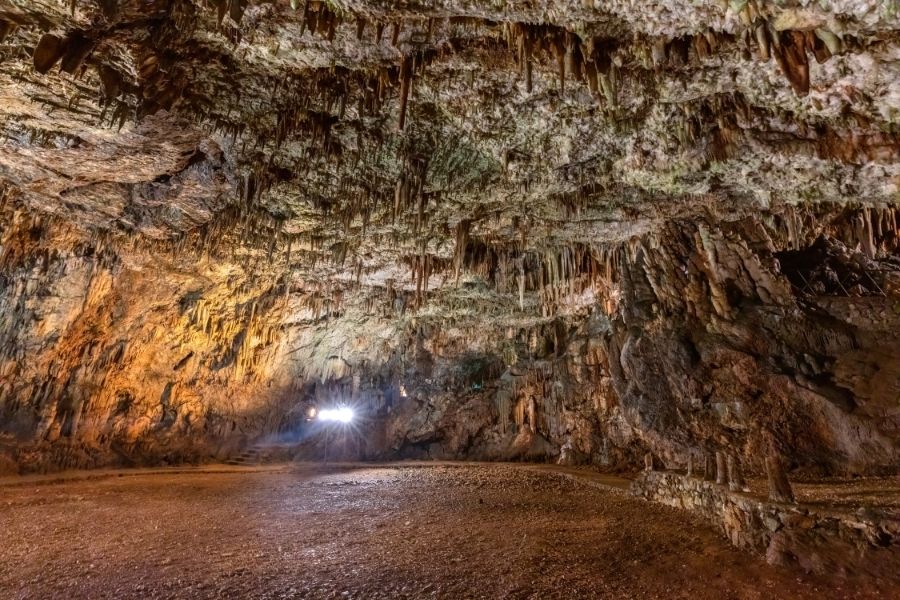
Cave Details:
- Discovered around 300 years ago.
- Famous for its incredible acoustics.
- Even legends like Maria Callas have performed here.
The sound inside is unreal. I could hear even the smallest whisper bounce around the chamber. They still hold concerts here, and I can see why.
Visitors only get to explore the first section of the cave. The steps can get pretty slippery, so I made sure to wear shoes with a good grip. There are about 165 steps leading down, so be ready for a bit of a workout.
Frequently Asked Questions
People always ask about Argostoli’s sea turtle spotting (which is epic), the wild sinkhole system, and how to really soak up Greek culture in the town squares. Others want tips on local food or the best places to stay.
What are the top attractions to visit in Argostoli?
Start with the Drapano Footbridge. It links Argostoli to Drapano and gives you some of the best harbor and mountain views around. I love snapping photos here or just wandering along for a romantic stroll.
The Argostoli Harbor is another highlight. If you’re lucky, you’ll spot sea turtles gliding through the clear water, especially when the weather’s warm.
Melissani Cave is about a 40-minute drive from Argostoli. Try to arrive around midday when sunlight beams into the cave and lights up the lake.
The Argostoli Sinkholes are a must for geology fans. Water rushes underground at 3 meters per second, eventually connecting with Drogarati Cave.
How can visitors experience the local culture in the plateias of Argostoli?
The plateias—Argostoli’s main squares—are where the town’s real spirit comes alive. Locals gather for coffee, catch up, and take evening strolls. At sunset, the energy just buzzes.
Cafes and restaurants circle the plateias. There’s nothing better than grabbing a seat outside, sipping Greek coffee or ouzo, and watching the world go by.
During summer, festivals and music fill the squares. I’ve seen traditional dancing and live bands turn the whole place into a party.
If you join an evening walk, you’ll experience the Greek tradition of “volta.” It’s when families and friends stroll together before dinner—simple, but it’s the heart of local life.
What is the significance of the sinkhole near Argostoli and how can it be accessed?
The Argostoli Sinkholes are a bit of a natural puzzle. Seawater vanishes into the ground here at crazy speeds. Scientists traced the water’s path all the way to caves across the island.
It travels underground for about 15 kilometers before reappearing at Melissani Cave. That’s a wild connection, right?
You can drive to the sinkholes in about 7 minutes from Argostoli’s center. There are information boards at the site that break down the science behind it.
Daylight’s the best time to visit, since you’ll see the water rushing in. I always recommend reading the signs—they make the whole thing even more fascinating.
Which local dishes should you try when visiting Argostoli, Kefalonia?
Gyros is a classic—soft bread wrapped around pork, tzatziki, and fries. It’s quick, filling, and you’ll find it everywhere.
Moussaka is Greek comfort food at its best. Many restaurants in Argostoli serve it, and each has its own twist on the layers of eggplant and meat sauce.
Fresh fish is a must. Local tavernas serve up the daily catch with olive oil, lemon, and herbs. Simple, but unforgettable.
Dolmades—grape leaves stuffed with rice and herbs—make a great starter. Pair them with a glass of local wine from Kefalonia’s vineyards and you’re set.
Are there guided tours available to explore Argostoli’s natural beauty and wildlife?
You can hop on boat tours to Melissani Cave from nearby Sami. These trips usually include transport and a guide who knows all the cave’s secrets.
Sea turtle watching tours focus on the harbor. Local guides know the best times and spots to see the turtles up close.
Walking tours of Argostoli hit all the big sights—the footbridge, sinkholes, and cultural hotspots. They usually last a couple of hours and come with plenty of stories.
If you want something tailored, private guides can customize the day. Whether you’re into geology, wildlife, or just want to see it all, there’s a tour for you.
What accommodations are recommended for staying in or near Argostoli?
The “L” Suites & Apartments really nails that adults-only luxury vibe. You get those gorgeous bay views, and the pool area feels so peaceful. It’s only about a ten-minute walk to the center of town, which is honestly pretty convenient.
Canale Hotel & Suites sits right in the heart of Argostoli. The rooms are modern, and some even have hot tubs looking out over the bay—can’t complain about that. There’s a spa, a swimming pool, and a restaurant, so you barely need to leave if you don’t want to.
Mouikis Hotel is a solid pick if you’re watching your budget but still want to be beside the sea. The rooftop bar has a hot tub, and there’s a small gym too. It’s not flashy, but it gets the job done.
If you’re after the cheapest option and don’t mind a bit of a walk, Galaxy Hotel is the way to go. It’s about thirty minutes from the center on foot. You’ll find the basics—WiFi, air conditioning, swimming pool—so it covers what you need for a simple stay.

